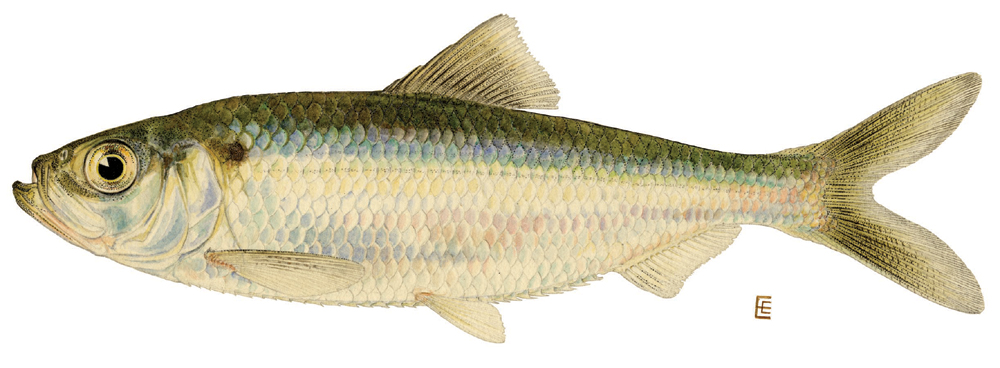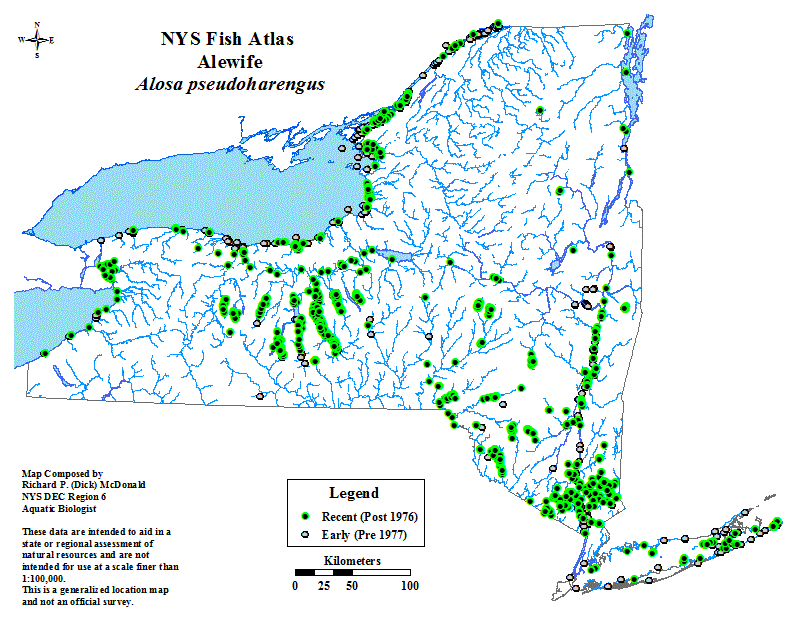
Alewife (Alosa pseudoharengus)
The alewife is a small herring having a greenish to bluish back and silvery sides with faint dark stripes. Although this species is overshadowed by other herring species in the marine environment, alewife are a key player in many freshwater lakes within which they have been introduced -- particularly the Great Lakes. Freshwater alewives, sometimes called sawbellys, are important as prey for popular game fish such as salmon and trout. They are extremely abundant in the Great Lakes, and are often regarded as a nuisance when large masses of these fish wash up on shorelines following large spring die-offs. Currently, alewives are a key player in a mysterious thiamine deficiency syndrome that has caused widespread reproductive failure in key native salmonine fishes, such as lake trout and Atlantic salmon. Alewives often contain thiaminase, which is an enzyme that causes thiamine deficiency in predators that eat alewives, yet mysteriously, alewives do not suffer from this thiamine deficiency. Ongoing research studies are underway to determine factors responsible for development of the thiamine deficiency syndrome.
Sea-run alewives are common near Long Island and in the Hudson and lower Mohawk rivers, and have also been reported from the St. Lawrence River. Landlocked alewives are common in Lake Ontario, Lake Erie, the Finger Lakes, Oneida Lake, Oswego River system, and Ballston and Round lakes. Alewives have also been introduced into various reservoirs in the upper Delaware drainage system (Pepacton and Cannonsville).
Sea-run alewives move up freshwater streams from the sea to spawn during the period from late April to early June. Spawning takes place in lakes and sluggish stretches of rivers above tidal influence. Landlocked alewives move from deep water to shallow beaches in lakes or move up streams to ponds to spawn in spring.
Females usually move to the spawning areas just before the males. Spawning takes place at night in groups of two or three over a sandy or gravelly bottom. Freshwater females deposit 10,000-12,000 eggs, whereas their sea-run counterparts produce 60,000-100,000 eggs. Eggs are broadcast randomly, are demersal (that is, they sink), and are not particularly adhesive. Adults leave the spawning area after spawning; no care is given eggs or young by the adult fish. In less than a week, the young alewives hatch to begin feeding on minute, free-floating plants and animals. By fall, the young alewives make their way back to the sea or, in the case of landlocked populations, to the deep waters of lakes. Landlocked alewives reach an average length of about 6 inches when adults, by contrast with marine alewives that reach much larger sizes.
Distribution of alewives in NY state.
An image of the alewife is also available for download.
